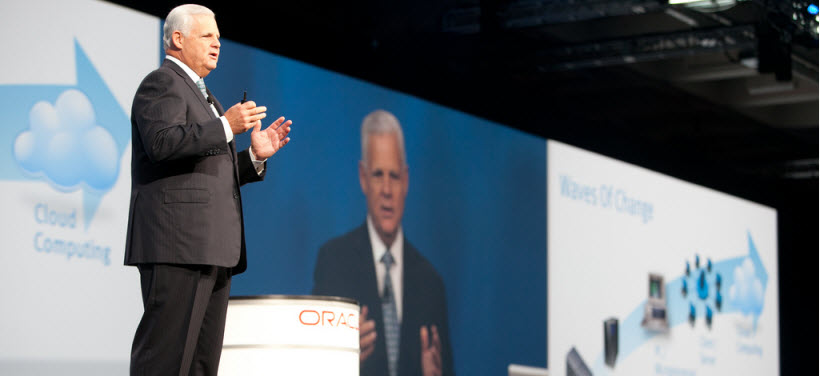 NEWS
NEWS
 NEWS
NEWS
 NEWS
NEWS
Could EMC cross up its critics and spin VMware, Inc. back in to the mother ship instead of spinning it out as activist investors have demanded?
That’s the scenario being floated by Arik Hesseldahl, senior enterprise editor at Re/code in an article published today. Hesseldahl cites no sources with inside knowledge of EMC’s plans, but notes that recent comments by CEO Joseph Tucci (above) indicate that a re-assimilation is possible.
Tucci told investors in the most recent earnings call that EMC plans to cut about $850 million in annual operating cost by the end of 2017. Hesseldahl says it’s likely those savings could be achieved solely by eliminating redundancies with VMware.
However, such a move would go against a lot of conventional wisdom, which holds that a spin-out would allow EMC to realize more value than its current 80 percent VMware stake. With a market capitalization of $37 billion, the virtualization kingpin accounts for nearly three-quarters of the total valuation of all EMC companies.
The move would be a final grand gesture for EMC CEO Joseph Tucci, who is expected to retire soon. Tucci’s recent tenure has been overshadowed by pressure from the hedge fund of Elliott Management, which has been actively agitating for the VMware spinoff. Tucci has defiantly maintained that VMware is a critical part of the EMC Federation of companies, which also includes RSA Security, LLC and Pivotal Software, Inc. The two sides called a temporary truce in January.
EMC’s Federation strategy is aimed at letting member companies strike their own partnerships and function effectively as independent units while still giving EMC a large amount of control. By digesting VMware, EMC would own 50 percent of the virtualization market and also a critical element of the emerging software-defined storage market with VMware’s Virtual SAN (VSAN). . With EMC’s traditional disk array sales declining, software defined storage is seen as being vital to its future.
However, assimilating VMware would also threaten the partnerships VMware has put into place, which are essential to building its presence in new markets.
Wikibon analysts said the spin-in could make sense but would introduce some complexity as well. Recently, EMC initiated a Federation “tiger team” approach that reports directly to Tucci and that presents a single account team to certain large customers, said Wikibon co-founder David Vellante. “That could be a petri dish for a spin-in,” he said.
But Wikibon Principal Research Contributor Stu Miniman cautioned that VMware was an EMC division long before the spin-out and that joint sales calls are nothing new. He said folding VMware back into the parent could also amount to “over-rotating” by EMC in the face of investor and market pressure.
Wikibon co-founder David Floyer suggested a scenario in which VMware could actually end up supplanting the EMC brand. “VMware is a systems management software company with a large installed base and it has the greatest potential growth” of any of the Federation companies, Floyer said. “Doing anything that does not maximize VMware potential would not make sense for EMC.”
But Miniman noted that while VMware’s valuation makes it the jewel in the Federation crown, it also faces a number of challenges outside of its core market. “Critical growth areas for VMware include storage (VSAN) and cloud (vCloud Air), which require a coordinated EMC Federation direction, regardless of corporate structure,” he wrote in an email interview.
Notwithstanding the spin-in discussion, Vellante believes that the Federation strategy was specifically designed to foster innovation and create value. “EMC could find synergies and squeeze $1 billion in costs by re-integrating, but it would lose the independent spirit that allowed VMware to thrive and led to the birth of Pivotal,” he said. The big question for EMC is how to break out of its valuation rut where its stock price has traded within a narrow band for years, he added.
Vellante said he sees two paths: Follow a playbook of paying dividends to EMC shareholders and continue to push innovation at the edge of the Federation to increase overall value, or going “all in” on vertical integration with Federation assets.
Vellante speculated that if EMC re-integrates VMware, it would essentially be following a path more akin to that of Oracle, which, as SiliconANGLE founder John Furrier recently wrote on Forbes, is engineering a full stack from silicon to software. The challenge with that approach, said Vellante, is that it de-leverages the VMware ecosystem without a full portfolio of assets from chips to apps.
The bottom line is that EMC is facing a conundrum: Stay the course and deal with disgruntled shareholders or declare all-out war on the competition and risk alienating a robust ecosystem during a turbulent market transition.
No wonder Tucci hasn’t been able to make a clean break from the company; it needs leadership more than ever.
Support our mission to keep content open and free by engaging with theCUBE community. Join theCUBE’s Alumni Trust Network, where technology leaders connect, share intelligence and create opportunities.
Founded by tech visionaries John Furrier and Dave Vellante, SiliconANGLE Media has built a dynamic ecosystem of industry-leading digital media brands that reach 15+ million elite tech professionals. Our new proprietary theCUBE AI Video Cloud is breaking ground in audience interaction, leveraging theCUBEai.com neural network to help technology companies make data-driven decisions and stay at the forefront of industry conversations.